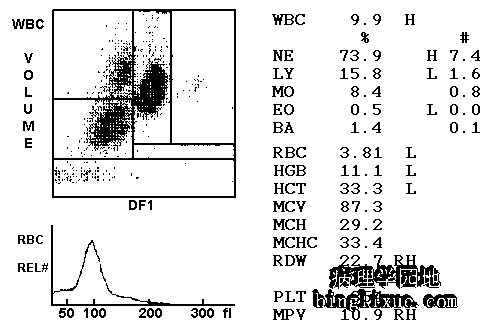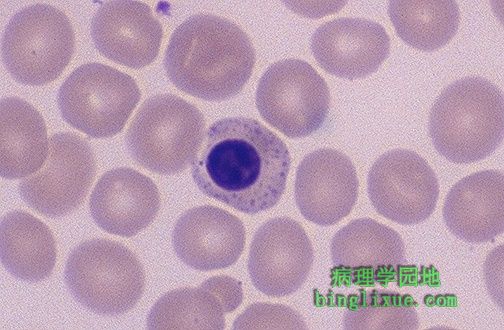
 |
可见为数众多的红细胞胞碎片,一些不规则的形状呈盔形,这样的红细胞称为裂体细胞,提示微血管病性溶血性贫血(MAHA)或其他原因的血管内溶血。裂体细胞多见于弥漫性血管内凝血(DIC)。 There are numerous fragmented RBC's seen here. Some of the irregular shapes appear as "helmet" cells. Such fragmented RBC's are known as "schistocytes" and they are indicative of a microangiopathic hemolytic anemia (MAHA) or other cause for intravascular hemolysis. This finding is typical for disseminated intravascular coagulopathy (DIC). |
 |
患有微血管病性溶血性贫血(MAHA)患者的全血细胞计数(CBC)显示RDW(红细胞分布宽度)明显地增加了,是因为红细胞的大小和形态发生了明显变化。 The CBC of a patient with microangiopathic hemolytic anemia (MAHA) demonstrates a markedly increased RDW (red cell distribution width) due to the marked variation in size and shape of the RBC population. |
 |
视野中心部分的RBC含有几个Howell-Jolly小体或残余的核染色质内容物。正好在这个红细胞的下方有一个有核红细胞。异常的和衰老的红细胞通常被脾清除。异形红细胞增多、红细胞大小不等以及红细胞内容物的出现均提示脾已不存在。 The RBC in the center of the field contains several Howell-Jolly bodies, or inclusions of nuclear chromatin remnants. There is also a nucleated RBC just beneath this RBC. Abnormal and aged RBC's are typically removed by the spleen. The appearance of increased poikilocytosis, anisocytosis, and RBC inclusions suggests that a spleen is not present. |
 |
全血细胞计数提示球形红细胞增多症,其红细胞小而圆(而不是正常的双面平凹外观),且血红蛋白含量增加。从MCHC(红细胞平均血红蛋白浓度)升高可见。这是极少见的遗传性球形红细胞增多症。 This CBC demonstrates findings suggestive of spherocytosis, a condition in which the RBC's are small and round (rather than the normal biconcave appearance) with increased hemoglobin content. This is indicated here by the increase MCHC (mean corpuscular hemoglobin concentration). There is a rare condition known as hereditary spherocytosis. Also, RBC's in the condition of autoimmune hemolytic anemia can also appear similarly. |
 |
大多数RBC体积很小,并且缺乏中部苍白的区域,是球形红细胞。在遗传性球形红细胞增多症中,因红细胞膜骨架蛋白缺乏,故膜通透性增加,从而导致细胞处于球形。在实验室中,可见渗透脆性增加。球形红细胞的寿命缩短。 The size of many of these RBC's is quite small, with lack of the central zone of pallor. These RBC's are spherocytes. In hereditary spherocytosis, there is a lack of spectrin, a key RBC cytoskeletal membrane protein. This produces membrane instability that forces the cell to the smallest volume--a sphere. In the laboratory, this is shown by increased osmotic fragility. The spherocytes do not survive as long as normal RBC's. |
 |
遗传性球形红细胞增多症中,窦状隙被RBC塞满,球形红细胞的渗透性脆性增加,因为RBC每单位体积的表面积减少。主要的临床症状是贫血,脾肿大和黄疸。短小病毒感染时可并发再障危象。 The sinusoids are packed with RBC's in this case of hereditary spherocytosis. The osmotic fragility of spherocytes is increased, because the RBC's have decreased surface area per unit volume. The major clinical features are anemia, splenomegaly, and jaundice. An aplastic crisis may occur with parvovirus infection. |
 |
中央的有核红细胞细胞质中含有嗜碱性点彩,提示骨髓毒性损伤,如铅中毒。另外, 这样的点彩在其他几种贫血症也可见,如巨幼红细胞贫血症。 The nucleated RBC in the center contains basophilic stippling of the cytoplasm. This suggests a toxic injury to the bone marrow, such as with lead poisoning. Such stippling may also appear with severe anemia, such as a megaloblastic anemia. |
 |
可见非典型淋巴细胞,之所以称为非典型,是因为体积更大(更多的细胞质)并可见核仁。 细胞质因RBC挤压而成锯齿形。多见于感染性单核细胞增多症。 The WBC's seen here are "atypical" lymphocytes. They are atypical because they are larger (more cytoplasm) and have nucleoli in their nuclei. The cytoplasm tends to be indented by surrounding RBC's. Such atypical lymphocytes are often associated with infectious mononucleosis. |
 |
如果大部分嗜中性粒细胞出现二叶,提示一种罕见的、遗传的、被称为Pelger-Huet异常。这是杂合子的情况。纯合子是致命的。诊断时,如果你得到的主要是经手工鉴别计数的结果,那么WBC计数却是正常的,或者患者显示无感染或炎症。 If most of the neutrophils appear bilobed, this is indicative of an uncommon condition known as Pelger-Huet anomaly, an inherited condition. This is the heterozygous form. The homozygous form is fatal. Just be aware of this condition when you get back a manual differential count with mostly bands, but the WBC count is normal or the patient shows no signs of infection or inflammation. |
 |
出现镰状细胞危象的镰状细胞贫血。当氧分压低时,异常的血红蛋白SS有结晶的倾向,并且RBC变长呈薄的镰刀样形状淤积在毛细管中,进一步降低血液流动性和氧分压。带有镰状细胞特性(血红蛋白AS)的人并不常发生这种情况。 This is sickle cell anemia in sickle cell crisis. The abnormal hemoglobin SS is prone to crystallization when oxygen tension is low, and the RBC's change shape to long, thin sickle forms that sludge in capillaries, further decreasing blood flow and oxygen tension. Persons with sickle cell trait (Hemoglobin AS) are much less likely to have this happen. |